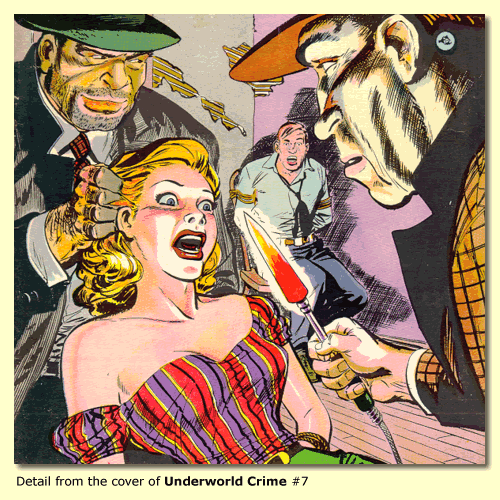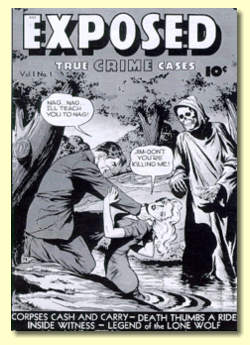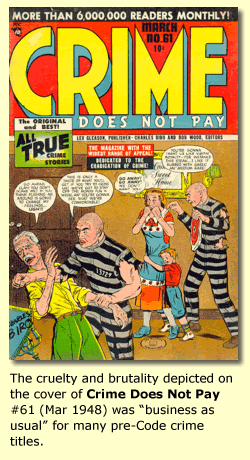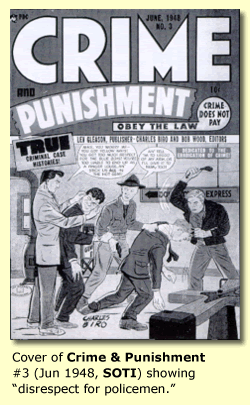
by Nicky Wright
Superheroes had their hands full during World War II. There were the Axis powers to beat...and they took some beating!... which meant millions plus sales of four color mayhem to ten-year-olds eagerly relishing the defeat of Hitler and his evil henchmen in every issue of Captain America and Human Torch. The enemy was always depicted as a terrifying monstrosity, as evil as all get out and great, scary fun as well.
But the war ended. Thankfully. Hangman, Sub-Mariner, Black Terror et al trudged home, their jobs done. The comic publishers watched sales drop. Down, down, went the profits, the golden years were over.
But one small publisher was doing just fine...and Leverett Gleason was his name. He published Crime Does Not Pay. Gleason started out with a pair of adventure comics called Silver Streak and Daredevil Comics in 1941. Later, he and then-partner Arthur Bernhard hired two artists from the comic art shop of Harry “A” Chesler to write and edit the new titles. They were Charles Biro and Bob Wood.

Wood and Biro had become friends at the Chesler shop. Charles Biro was as tall as a basketball player and had a talent, not only for drawing, but writing and marketing as well. Bob Wood was..or appeared to be...quieter, more withdrawn. The two hit it off and made a perfect pair to work on Bernhard’s and Gleason’s new comics.
Gleason was politically a left wing liberal, very committed to his beliefs which extended to giving Biro and Wood a share of the profits his company, Comic House, was making. This was unheard of in an industry more likely to take their artists and writers to the cleaners rather than give them anything other than the bare bones of a wage. With the views Gleason believed in, it was natural that he deplored everything Hitler stood for, and the first issue of Daredevil was memorable indeed. The cover depicted Hitler and the blue and red cat-suited Daredevil with the words “Daredevil Battles Hitler” emblazoned across the illustration. The somewhat busy artwork was by Bob Wood.
Both new titles sold well, especially Daredevil which was to continue for 134 issues until September 1956. Pleased with his editors, Gleason reportedly told them that if they could come up with a new idea tha would prove popular, both men would be rich. One night Biro and Wood were sitting in a bar discussing ideas when Biro remembered the time he had been approached by a man who offered him a “indiscreet rendezvous” with a woman. Biro declined. The very next day Charles spotted the man’s picture in the paper...he’d been arrested for kidnapping the woman! He told Wood about the incident and suggested a comic book dealing with gangsters and murderers, real and imagined.
Both men became much enthused with the idea and told Gleason who immediately gave the OK to proceed. The title was to be the now-famous Crime Does Not Pay which was inspired by MGM’s popular mid-’30s movie series of the same name. (Amazingly, MGM never sued anybody!)
A 64-page comic, Crime Does Not Pay replaced Silver Streak but continued its numbering with issue #22. This numbering anomaly was favored by comic publishers because it avoided the postal permit fee for entering a new title as second class matter.
 The
first issue was entirely different from the other titles on the stands.
Dated July 1942, Crime Does Not Pay featured strips and actual
articles about real criminals. “True Crime Cases” shouted to
readers over photographs of vicious felons like Killer Lapke and other
notorious villains. The Biro-illustrated cover was cramed full of murder
and mayhem. When I was purchasing my first copy by phone, the seller described
the cover like this: “there’s a guy with a tommy gun holding
a young woman and blasting away at everything. A pair of hands in the
foreground drops a handgun and you see that part of his hand is blown
away. And between the covers it gets worse; the violence is unbelievable.”
The
first issue was entirely different from the other titles on the stands.
Dated July 1942, Crime Does Not Pay featured strips and actual
articles about real criminals. “True Crime Cases” shouted to
readers over photographs of vicious felons like Killer Lapke and other
notorious villains. The Biro-illustrated cover was cramed full of murder
and mayhem. When I was purchasing my first copy by phone, the seller described
the cover like this: “there’s a guy with a tommy gun holding
a young woman and blasting away at everything. A pair of hands in the
foreground drops a handgun and you see that part of his hand is blown
away. And between the covers it gets worse; the violence is unbelievable.”
And it was unbelievable. And it got even worse in follow-on issues. Biro and Wood sought out tales of nastiest killers, the cruelest mobsters, and the most vicious gun molls. “All True Crime Stories” screamed from the covers under 3” high letters spelling “Crime.” The words “Does Not Pay” were a mere ¼” in height. The word “Crime” was clearly what sold the title!
By war’s end, Gleason couldn’t keep up with demand. Adults bought the comics in droves...and children, faced with a choice of gritty realism or declining interst in superheroes, plunked their dimes down for Crime Does Not Pay. The first few issues sold a healthy 200,000 copies but by 1946 saled had zoomed to 800,000 an issue. By ’48, the title was hitting sales of almost a million per month. To help with promotion, Biro splashed the words “More than 5,000,000 Readers Monthly” above the title. Shortly after this was increased to six million, a total no doubt arrived at by the number of supposed readers after the comic had been bought. (It was a common practie among comic publishers to multiply the print run times five to get circulation. This was based on the idea that comics were passed on to at least four other readers after the original purchase.)
 From
1942 until 1947, Crime Does Not Pay was number one in a field of
one. Its original, simplistic and cartoony art gave way to more gritty
realism with the regular use of excellent artists like George Tuska, Dan
Barry, and Bob Fujitani. These three turned Biro’s wordy but brutal
scripts into memorable, blood gushing nastiness on every page. As comics
go, Crime Does Not Pay was anything but nice. Superheroes were
fun and fantasy, funny animals were funny, and Classics attempted
to bring youngsters great literature. In contrast, Crime Does Not Pay
traded on America’s love of ultra violence. As parent groups and
clergy became more and more alarmed, sales continued to boom.
From
1942 until 1947, Crime Does Not Pay was number one in a field of
one. Its original, simplistic and cartoony art gave way to more gritty
realism with the regular use of excellent artists like George Tuska, Dan
Barry, and Bob Fujitani. These three turned Biro’s wordy but brutal
scripts into memorable, blood gushing nastiness on every page. As comics
go, Crime Does Not Pay was anything but nice. Superheroes were
fun and fantasy, funny animals were funny, and Classics attempted
to bring youngsters great literature. In contrast, Crime Does Not Pay
traded on America’s love of ultra violence. As parent groups and
clergy became more and more alarmed, sales continued to boom.
By 1947 other publishers were beginning to feel the pinch of mounting public disquiet over Crime Does Not Pay, but they jumped on the crime genre bandwagon anyway. While few could match the imaginative scripts and art of Biro and Wood, other publishers worked hard to incorporate more gratuitous violence into their crime books. And as the competition got more violent, so did Crime Does Not Pay. Issues #40-70, published during 1945-48 consistently pushed the boundaries to the extreme. Nothing seemed off-limits...sexual perversion, pistol whippings, obvious rape, stabbings, throat slitting, maiming, torture...the lurid and bloody pictures told the tale.
![]()
The year 1948 saw an incredible proliferation of crime comics at the drug
store and newsstand. Victor Fox, comicdom’s “king of sleaze,”
waded in with lurid tales of his own.
His Crimes By Women, followed by the provocatively titled Murder Incorporated were notable and now highly collectible examples. Ace Magazines came out with Crime Must Pay the Penalty, and Hillman with Crime Detective Comics. Marvel/Atlas saw a trend, and Martin Goodman waded in with Crime Exposed and Crime Fighters. Authentic Police Cases and Crime Reporter were St. John Publishing’s contribution, and Captain Marvel’s publisher, Fawcett, produced On the Spot, a well-written one-shot comic on the life of Pretty Boy Floyd. Even DC got into the act with generally sanitized Gang Busters, which was similar to the earlier Dell/McKay version. And EC brought out Crime Patrol.
Charles Biro and company were not pleased. And said so in their readers’ letters column. To counter the “imitators” they introduced Crime and Punishment. This was really Crime Does Not Pay with a different cover, though Crime Does Not Pay had an interlocutor in the form of a very cynical gent called Mr. Crime. A foul looking ghost, he egged his criminal disciples on...“She’s lying, Clay, a frill can land you in the hot squat the same as any double crossin’ mug can! Heat that poker it’ll take guts to burn a doll’s face!” Amazing prose to enlighten and educate eight-year-old lads about the proper way to handle relationships with women.
 Another
example comes from the first story in Crime Does Not Pay #61 (March
1948) and concerns “Clay Fogelman, Meanest Man in Crime.”
Another
example comes from the first story in Crime Does Not Pay #61 (March
1948) and concerns “Clay Fogelman, Meanest Man in Crime.”
In an effort to make the stories look authentic, the first splash page has a disclaimer written in the illustration: “In consideration of innocent people involved and relatives of others, the names of some characters depicted in this true magazine are fictitious. The Editors.” In this case the Fogelman splash page shows him holding a poker over a heated oven with his left hand while his right twists a sobbing girl’s arm behind her back. She is wearing a skintight red dress, the shoulder part having slipped down her arm. On the other side of the room, Clay’s buddy holds a gun to the girl’s husband and cheerfully says: “Sit still, you grease! Your wife asked for it!”
Biro had a knack for making it sound real.
The story begins as Clay calmly shoots his two buddies in the back of the head. Clay leans over one of his victims who is lying, face down on the pavement, a liberal amount of blood soaking the ground. “You like to make speeches,” Clay smiles, “so now I’ll make one! There’s a new look in your eyes, Benny! It’s the look that comes over a guy’s face when the blood’s pourin’ out of his heart! Too bad you can’t hear me!”
Clay drives off. In the car he chortles to himself thinking how lucky he is to have the $60,000 all to himself. He wants to enjoy the money with someone, especially a redhead. Clay has a weakness for redheads and it isn’t long before he finds one.
Women had a bad time of it in crime comics. They were either gangster’s molls, gun molls, or hapless victims enduring horrors never found in the movies of magazines of the day.
Clay Fogelman’s redhead was told in no uncertain terms not to interfere. “...don’t ask questions” and “...do what you’re told.” She grabs Fogelman by the head and presses him to her lips. “Kiss me!” she breathes. “Kiss me hard, you...you brute!”

